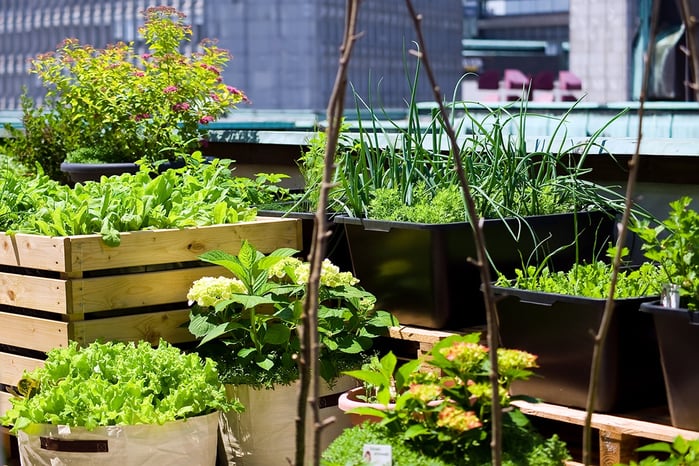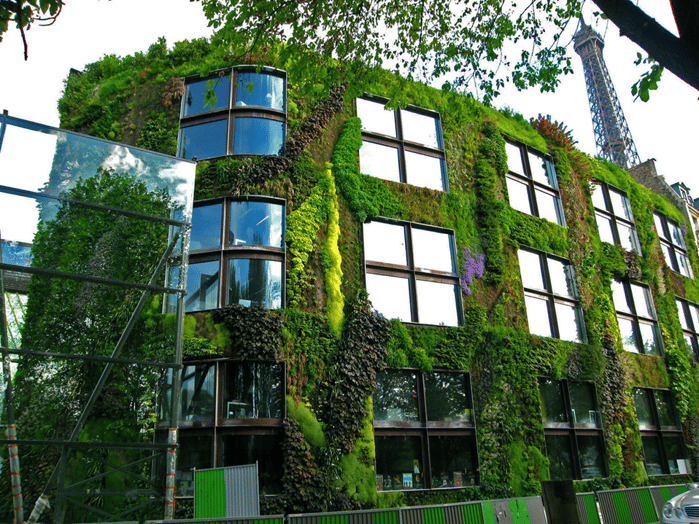But first a few words on the history of vertical farming...
Before Gilbert Ellis Bailey, PhD invented the phrase “vertical farming” people lived in harmony with nature for thousands of years. Actually, it all started with hanging gardens of Babylon.

In ancient Rome in the year 500, the Romans were growing grapes that climbed walls or wooden structures. Around 1150, the Aztecs were growing food in floating gardens. And in the 15th century the Incas were building forts to support their efforts to bring soil from the valleys to the mountains in order to plant for food.
Designer and artist Charles-Édouard Jeanneret-Gris, better known as the renowned architect Le Corbusier, also had a substantial impact on vertical farming or growing. In his “Le Immuebles Villas” project from 1922 he presented sketches and renders for the first modern buildings to feature vertical plantings. Later on, in 1938, Professor of Landscape Architecture Stanley Hart White patented a special type of horticultural bricks for vertical growing. And it was Patric Blanc who patented the first green wall with a supporting system for watering and providing nutrients to the plant life and who, therefore, is referred to as “the father of the green wall.” More recently, the first renders for a concept for an open farming community were shown in 1989 by architect Kenneth Yeang – and the wheel of development continues to turn…
As we can see from the many different people involved in this history, the practice of vertical farming consists of a combination of skills in architecture, structural engineering, horticulture, waterproofing technology, mechanical and electrical engineering and installations, and finally programming skills.
Population growth, changing preferences and eating habits, and ecological inputs are key factors affecting the accelerated development of new growing techniques and materials
New, intense desires and needs also move people to greater consumption of food, too. As technology evolves, eating habits are also changing. In the past, it was enough for people to have food; later, cutlery and tableware were added to the equation; and nowadays, in addition to taste, people put ever- greater emphasis on the appearance and nutritional value of what they eat.
People have started to realize that they themselves contribute to their own better of quality of life by selecting nutritious, quality food, and by moving around in the fresh air outdoors. We could say a new people’s guide to eating is “food with high nutritional value and superfoods for healthy living” and “food for soul”.
As a result, horticulture is becoming an increasingly powerful economic superpower, which has repercussions on employment and livelihood, and contributes to higher incomes as well as quality of life and general satisfaction of the population.
BUT, healthy living is polluting our nature...
At the same time, by eating increasingly healthier food, we cannot ignore the fact that farming all over the world today uses as much as 70% of all our drinking water and represents some 14% of global greenhouse gas emissions (IPCC, 2007). Farming is also polluting the earth and water with excess nutrients, pesticides and other pollutants.
However, for some people, food production means survival, while for others it is increasingly becoming a way of life and source of pleasure – and these people are also prepared to pay more for quality food.
All of this activity takes place inside a closed loop, where we also need to consider the sustainability component in order to preserve the natural environment for future generations.
And that’s the works of and for scientists, who are now doing research and development in the hopes of discovering new growing techniques, means and materials.
Urban farms using unconventional cultivation methods are becoming a major trend the world over
Already some new, revolutionary methods of cultivation are being developed, which, according to some experts, will bring major changes to the field of food production.
Urban farms using unconventional cultivation methods are becoming a major trend the world over, as they can be self-sufficient and can serve as a source of income. According to various estimates on actual food consumption and population growth, we should definitely be thinking in the direction of new, alternative production technologies and growing spaces.
New types of farming and green infrastructure
1. Roof gardens
On the roof we can cultivate a variety of plant species, depending on the built structure and materials used. They may be walkable or non-walkable, which depends on the plant species growing there. On the roof, various kinds of vegetables can be also grown, but the statics and load capacity of the roof should be taken into consideration. Also, only a thin substrate layer can be used on the rooftop. Therefore, high beams (raised beds), one of the most popular methods of cultivation at the moment, is a potential solution for rooftop installation.

2. Green walls
Green walls are one of the most complex and least researched in the horticultural sector, agriculture and in architecture. Gardeners are faced with various challenges, including how to regulate watering, the adding of nutrients, the falling of water into the lower parts of the walls, and quick water drainage (under the force of gravity).
But although we have a lot of names to describe green walls, all of the names used actually describe a characteristic of a single wall – specific types of panels with growing mediums are used for the construction of such walls.
Green walls can have different functions:
- Some green walls are used for covering the concrete wall and to improve the aesthetic effect.
- Some people do not have gardens, so they use a vertical garden to grow crops.
One specific category of green walls is a green facade, which needs to be distinguished from a single green wall – for with green facades plants that grow only at the foot of the façade are used (as opposed to special panels with a growing medium all over the wall). In addition, those specific types of plants that are used in green facades and grow from the bottom of the facade completely cover the façade structure and transform it into a “growing and green”.
However, if something useful and edible grows on the walls, it can be called a vertical garden. What is common, however, to all green walls is vertical growth, and a special growing medium with its own irrigation system.

For more information on Green Walls read our blog Green wall: another dimension of a green roof?
3. Vertical cultivation in greenhouses (warehouses, containers, growing chambers)
Greenhouse cultivation means cultivation in a controlled environment, such as a warehouse, container, or a dedicated growing chamber using hydroponic systems on different growing media.
This is not a new practice, but one that goes back to Roman times, but has experienced a renaissance in recent years and become more widely available, more sophisticated and less expensive (Indoor.ag, 2016).
What we call “indoor farms” have all of the appropriate robotics and controlled operations and are referred to as “plant factories”, “plant factories with artificial light”, “vertical farms” or “controlled environment Agriculture (CEA)”.

At the moment, cultivation in old warehouses, containers and growing chambers is widely used in Asia. This is a market that due to particular population growth invests a lot of resources into food production. And due to the air pollution issues Asia has to contend with growing in chambers is the most appropriate way of growing food.
Interested in solutions Urbanscape can offer for those new types of farming and green infrastructure?
Download Urbanscape Landscaping Solutions Brochure below or check our website to learn more about our solutions to be used in new, unconventional ways of farming and growing.
Interested in more details about vertical farming?
Subscribe and read our next blog and learn more about:
- The main characteristics of these farms
- The functions (benefits) of vertical farming
- Types of possible plant production



